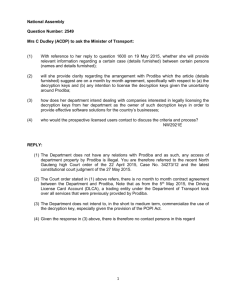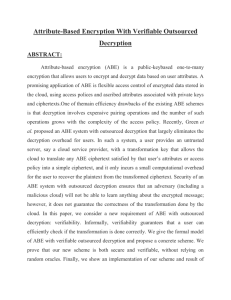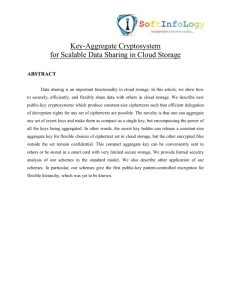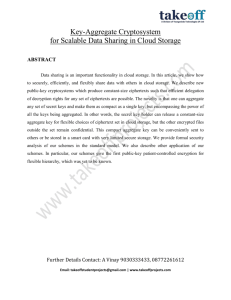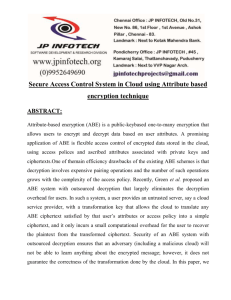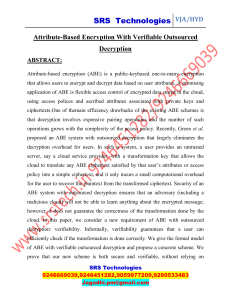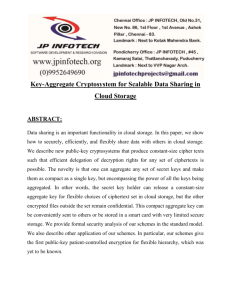- Krest Technology
advertisement
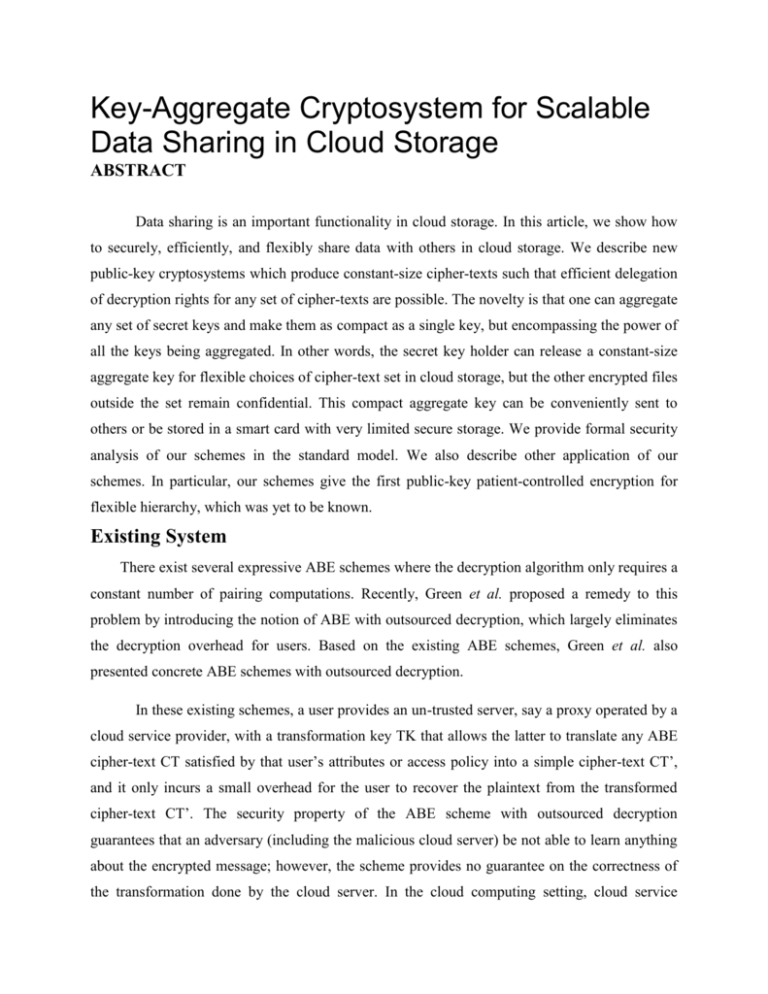
Key-Aggregate Cryptosystem for Scalable Data Sharing in Cloud Storage ABSTRACT Data sharing is an important functionality in cloud storage. In this article, we show how to securely, efficiently, and flexibly share data with others in cloud storage. We describe new public-key cryptosystems which produce constant-size cipher-texts such that efficient delegation of decryption rights for any set of cipher-texts are possible. The novelty is that one can aggregate any set of secret keys and make them as compact as a single key, but encompassing the power of all the keys being aggregated. In other words, the secret key holder can release a constant-size aggregate key for flexible choices of cipher-text set in cloud storage, but the other encrypted files outside the set remain confidential. This compact aggregate key can be conveniently sent to others or be stored in a smart card with very limited secure storage. We provide formal security analysis of our schemes in the standard model. We also describe other application of our schemes. In particular, our schemes give the first public-key patient-controlled encryption for flexible hierarchy, which was yet to be known. Existing System There exist several expressive ABE schemes where the decryption algorithm only requires a constant number of pairing computations. Recently, Green et al. proposed a remedy to this problem by introducing the notion of ABE with outsourced decryption, which largely eliminates the decryption overhead for users. Based on the existing ABE schemes, Green et al. also presented concrete ABE schemes with outsourced decryption. In these existing schemes, a user provides an un-trusted server, say a proxy operated by a cloud service provider, with a transformation key TK that allows the latter to translate any ABE cipher-text CT satisfied by that user’s attributes or access policy into a simple cipher-text CT’, and it only incurs a small overhead for the user to recover the plaintext from the transformed cipher-text CT’. The security property of the ABE scheme with outsourced decryption guarantees that an adversary (including the malicious cloud server) be not able to learn anything about the encrypted message; however, the scheme provides no guarantee on the correctness of the transformation done by the cloud server. In the cloud computing setting, cloud service providers may have strong financial incentives to return incorrect answers, if such answers require less work and are unlikely to be detected by users. Disadvantages: Naturally, there are two extreme ways for her under the traditional encryption paradigm: Alice encrypts all files with a single encryption key and gives Bob the corresponding secret key directly. Alice encrypts files with distinct keys and sends Bob the corresponding secret keys. Obviously, the first method is inadequate since all un-chosen data may be also leaked to Bob. For the second method, there are practical concerns on efficiency. The number of such keys is as many as the number of the shared photos, say, a thousand. Transferring these secret keys inherently requires a secure channel, and storing these keys requires rather expensive secure storage. The costs and complexities involved generally increase with the number of the decryption keys to be shared. In short, it is very heavy and costly to do that. Proposed System: We considered the verifiability of the cloud’s transformation and provided a method to check the correctness of the transformation. However, the we did not formally define verifiability. But it is not feasible to construct ABE schemes with verifiable outsourced decryption following the model defined in the existing. Moreover, the method proposed in existing relies on random oracles (RO). Unfortunately, the RO model is heuristic, and a proof of security in the RO model does not directly imply anything about the security of an ABE scheme in the real world. It is well known that there exist cryptographic schemes which are secure in the RO model but are inherently insecure when the RO is instantiated with any real hash function. In this thesis work, firstly modify the original model of ABE with outsourced decryption in the existing to allow for verifiability of the transformations. After describing the formal definition of verifiability, we propose a new ABE model and based on this new model construct a concrete ABE scheme with verifiable outsourced decryption. Our scheme does not rely on random oracles. In this paper we only focus on CP-ABE with verifiable outsourced decryption. The same approach applies to KP-ABE with verifiable outsourced decryption. To assess the performance of our ABE scheme with verifiable outsourced decryption, we implement the CP-ABE scheme with verifiable outsourced decryption and conduct experiments on both an ARM-based mobile device and an Intel-core personal computer to model a mobile user and a proxy, respectively. Advantages: Minimizing the communication requirements (such as bandwidth, rounds of communication) like aggregate signature. Alice encrypts files with distinct public-keys, but only sends Bob a single (constant-size) decryption key .Since the decryption key should be sent via a secure channel and kept secret. Small key size is always enough. Problem Statement One of the main efficiency drawbacks of the most existing ABE schemes is that decryption is expensive for resource-limited devices due to pairing operations, and the number of pairing operations required to decrypt a cipher-text grows with the complexity of the access policy. The above observation motivates us to study ABE with verifiable outsourced decryption in this thesis work. Here emphasized that an ABE scheme with secure outsourced decryption does not necessarily guarantee verifiability (i.e., correctness of the transformation done by the cloud server). Architecture: ciphertext data user attributes Encryption Encrypted attributes key cloud retriever attributes Encrypted attributes encryption key Outsource decryption verification ciphertext Access structure plaintext MODULES” 1. Setup Phase 2. Encrypt Phase 3. KeyGen Phase, 4. Decrypt Phase Modules Description SETUP PHASE The setup algorithm takes no input other than the implicit security parameter. It outputs the public parameters PK and a master key MK. ENCRYPT PHASE Encrypt(PK,M, A). The encryption algorithm takes as input the public parameters PK, a message M, and an access structure A over the universe of attributes. The algorithm will encrypt M and produce a ciphertext CT such that only a user that possesses a set of attributes that satisfies the access structure will be able to decrypt the message. We will assume that the ciphertext implicitly contains A. 3 KEY GEN PHASE Key Generation(MK,S). The key generation algorithm takes as input the master key MK and a set of attributes S that describe the key. It outputs a private key SK 4 DECRYPT PHASE Decrypt (PK, CT, and SK). The decryption algorithm takes as input the public parameters PK, a ciphertext CT, which contains an access policy A, and a privatekey SK, which is a private key for a set S of attributes. If the set S of attributes satisfies the access structure A then the algorithm will decrypt the ciphertext andreturn a message M. System Configuration:- H/W System Configuration:Processor - Pentium –III Speed - 1.1 Ghz RAM - 256 MB (min) Hard Disk - 20 GB Key Board - Standard Windows Keyboard Mouse - Two or Three Button Mouse Monitor - SVGA S/W System Configuration:- Operating System Front End Scripts Database : MySQL Database Connectivity : JDBC. :Windows95/98/2000/XP : Swings & AWT : JavaScript. CONCLUSION How to protect users’ data privacy is a central question of cloud storage. With more mathematical tools, cryptographic schemes are getting more versatile and often involve multiple keys for a single application. In this article, we consider how to “compress” secret keys in public-key cryptosystems which support delegation of secret keys for different ciphertext classes in cloud storage. No matter which one among the power set of classes, the delegatee can always get an aggregate key of constant size. Our approach is more flexible than hierarchical key assignment which can only save spaces if all key-holders share a similar set of privileges.
